Sony Ericsson T612 User Manual
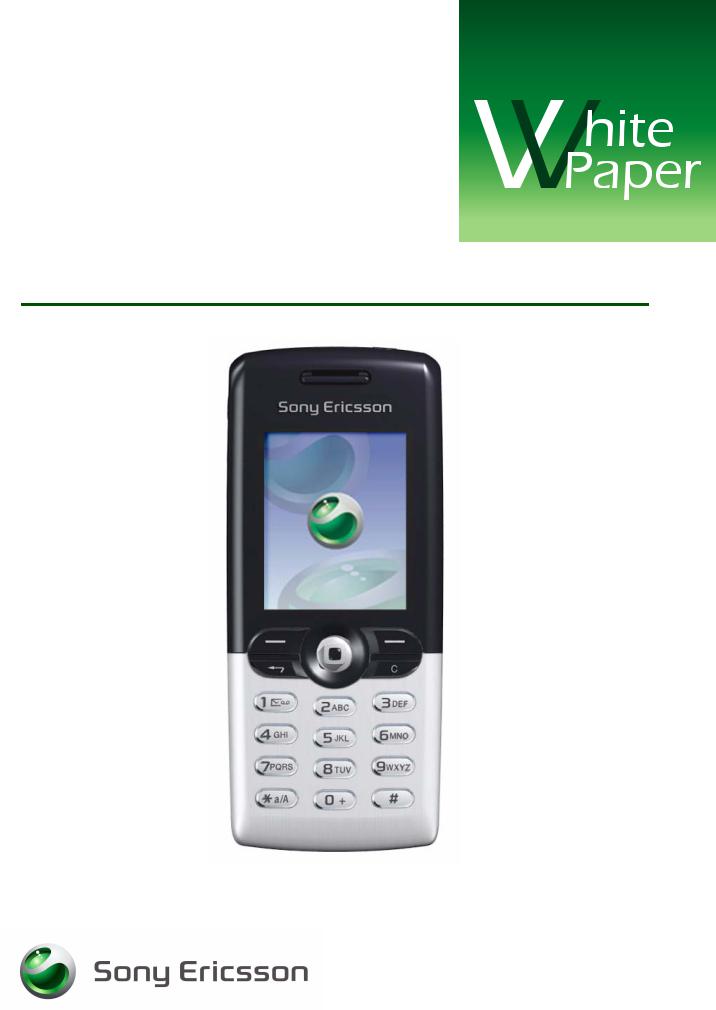
T610/T612

White Paper T610/T612
Preface
Purpose of this document
The Sony Ericsson T610/T612 White Paper is designed to give the reader a deeper technical understanding of how the T610 and T612 is designed, and of how it interacts with other media. This document will make it easier to integrate the T610 and T612with the IT and communications solutions of a company or organization.
People who can benefit from this document include:
•Corporate buyers
•IT Professionals
This White Paper is published by:
Sony Ericsson Mobile Communications AB,
SE-221 88 Lund, Sweden
Phone:+46 46 19 40 00
Fax: +46 46 19 41 00
www.SonyEricsson.com/
Second edition (December 2002) R2A
Publication number: EN/LZT 108 6196
•Software developers
•Support engineers
•Business decision-makers
More information, useful for product, service and application developers, is published at http://www.SonyEricsson.com/mobilityworld/, which contains up-to-date information about technologies, products and tools.
This document is published by Sony Ericsson Mobile Communications AB, without any warranty.
Improvements and changes to this text necessitated by typographical errors, inaccuracies of current information or improvements to programs and/or equipment, may be made by Sony Ericsson Mobile Communications AB at any time and without notice. Such changes will, however, be incorporated into new editions of this document. Any hard copies of this document are to be regarded as temporary reference copies only.
White Paper T610/612
Contents
Purpose of this document ..................................................................................................... |
2 |
Features and functions ............................................................................................................. |
6 |
Built-in CommuniCam ......................................................................................................... |
6 |
Pictures ................................................................................................................................. |
6 |
Multimedia in T610/612 ...................................................................................................... |
6 |
MMS (Multimedia Messaging Service) ............................................................................... |
7 |
MMS objects ........................................................................................................................ |
7 |
Benefits ................................................................................................................................ |
9 |
EMS (Enhanced Messaging Service) ................................................................................. |
11 |
Messaging using EMS ....................................................................................................... |
11 |
New and innovative user interface ..................................................................................... |
13 |
Java .................................................................................................................................... |
14 |
Games ................................................................................................................................ |
15 |
MIDI - Musical Instrument Digital Interface ..................................................................... |
16 |
Polyphonic ring signals ...................................................................................................... |
16 |
Bluetooth™ wireless technology ....................................................................................... |
17 |
Using Bluetooth wireless technology in the T610/612 ...................................................... |
17 |
Synchronize calendar and phone book .............................................................................. |
18 |
SyncML, an open standard for remote synchronization in the T610/612 .......................... |
18 |
Local synchronization ........................................................................................................ |
20 |
WAP services ..................................................................................................................... |
21 |
Bearer type characteristics ................................................................................................. |
23 |
Gateway characteristics ..................................................................................................... |
23 |
Security using the WAP ..................................................................................................... |
23 |
Configuration of WAP settings .......................................................................................... |
24 |
Push services ...................................................................................................................... |
25 |
Mobile Internet ................................................................................................................... |
25 |
Data connections ................................................................................................................ |
25 |
Mobile positioning ............................................................................................................. |
26 |
General Packet Radio Services .......................................................................................... |
26 |
Using GPRS in the T610/612 ............................................................................................ |
26 |
Modem and AT commands ................................................................................................ |
27 |
GSM data communication ................................................................................................. |
27 |
AT commands support ....................................................................................................... |
28 |
Infrared transceiver ............................................................................................................ |
29 |
Connection via infrared ...................................................................................................... |
29 |
Chinese versions ................................................................................................................ |
29 |
In-phone functions and features ............................................................................................. |
30 |
Network-dependent features .............................................................................................. |
35 |
SIM application toolkit ...................................................................................................... |
35 |
SIM AT services supported by the T610/612 .................................................................... |
35 |
User interaction with SIM AT ........................................................................................... |
39 |
Security and M-commerce technical data .......................................................................... |
40 |
Terminology and abbreviations ......................................................................................... |
41 |
Related information ........................................................................................................... |
44 |
Technical specifications ......................................................................................................... |
45 |
General technical data ........................................................................................................ |
45 |
Exterior description ............................................................................................................ |
45 |
Ambient temperatures ........................................................................................................ |
46 |
3 |
December 2002 |
White Paper T610/612
Supported Man-Machine Interface (MMI) languages ....................................................... |
46 |
Current consumption, talk and standby times .................................................................... |
47 |
Speech coding .................................................................................................................... |
47 |
Cell broadcast service ........................................................................................................ |
47 |
Short message service ........................................................................................................ |
49 |
Enhanced message service ................................................................................................. |
51 |
Multimedia message service .............................................................................................. |
53 |
Bluetooth technical data ..................................................................................................... |
55 |
Performance and technical characteristics ......................................................................... |
55 |
Tone and percussion maps in the T610/612 ...................................................................... |
56 |
Percussion map .................................................................................................................. |
58 |
WAP browser technical data .............................................................................................. |
60 |
WAP Operator technical data ............................................................................................ |
62 |
GPRS technical data .......................................................................................................... |
66 |
Built-in GSM data modem technical data .......................................................................... |
68 |
E-mail client technical data ................................................................................................ |
68 |
USSD technical data .......................................................................................................... |
70 |
Image format technical data ............................................................................................... |
70 |
Images – downloading to phone ........................................................................................ |
70 |
SyncML technical data ...................................................................................................... |
72 |
Infrared transceiver technical data ..................................................................................... |
72 |
4 |
December 2002 |
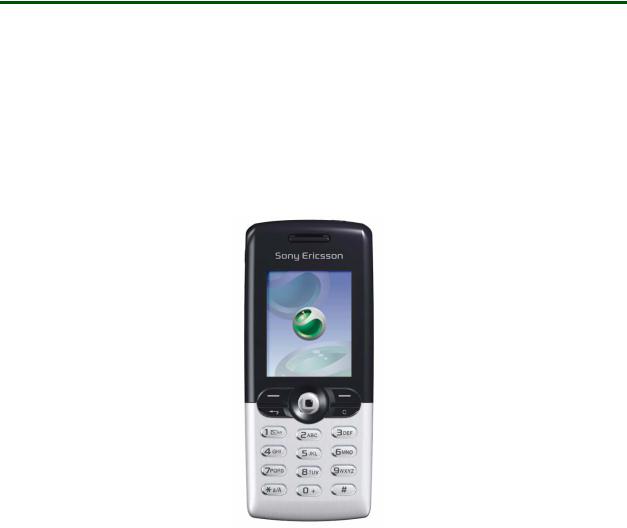
White Paper T610/612
T610/12 overview
T610/612 is an innovative and easy to use high-end mobile phone. It offers complete imaging and messaging capabilities that allow both family and friends to capture, share and preserve those special moments.
Designed with professional user in mind, T610/612’s powerful efficiency makes it an ideal tool in the professional work place.
Featuring a large colour LCD display with 65536 colours, it offers the viewer sharp, detailed images in rich, natural colours. The built-in camera makes taking a picture quick and easy and automatically shows the subject in the display. Pictures can then be used as wallpapers, in multimedia messages and in the phone book.
5

White Paper T610/612
Features and functions
Built-in CommuniCam
The built-in camera is capable of taking still pictures up to common image format (CIF) resolution (352x 288 pixels) and 24 bit colour depth. The lens is recessed into the back of the T610/612. The viewfinder will fill up the whole screen, irrespective of the resolution at which the picture is taken. A dedicated hardware button provides fast access to the camera application.
Images are stored in the phone’s filing system and are therefore available for other applications to use. The number of images that can be stored depends on the available file space, which is shared with other applications. The viewfinder will give an estimation of the number of images remaining, assuming that all of the free storage is available for the camera application and using the current settings for size and quality. Approximate JPEG file sizes are 20 kbytes for CIF.
Saved images may be viewed in the image viewer application, and are available for use by other applications in T610/612 such as MMS and e-mail.
The camera is optimised for ‘point-and-shoot’ speed. The first press on the CommuniCam button will switch on the viewfinder. Each subsequent press on the button will then act as a shutter release and take a picture.
Settings are accessed via softkeys and include: Image size – Large/Small, default picture name and a flickerfree mode setting.
Pictures
Pictures is the T610/12’s image viewer. It enables you to view and organise your photographs, including pictures taken by the built-in camera plus images loaded from elsewhere, such as received via e-Mail. Pictures supports image types JPEG, BMP, GIF, MBM, PNG and WBMP.
Pictures can be viewed in thumbnail and full screen mode. Thumbnail images may be ordered by name, date, size or type. In full screen mode the user can browse through the images and rename or delete them. It is also possible to send them as e-mail or MMS messages. Simply select a picture, add a message and send just like an
SMS message or build a slide show with several images and your favourite sound clips.
Pictures of loved ones can be saved in Contacts. When a contact calls (or the user calls that contact), the picture is displayed with the details of the call. This is known as Picture Phone Book.
Pictures may be loaded up to the Internet. Sony Ericsson Mobile Internet has an on-line album enabling you to share pictures and video clips: wap.sonyericsson.com
Multimedia in T610/612
Graphics
Graphics (tables, charts, diagrams and layouts) have a major impact on the way we work. The T610/612 supports JPEG (max 640x480), GIF (max 160x120), WBMP (max 320x320) and animated GIFs. With MMS,
the user can personalize the appearance of the display – for example the background colours and the background picture.
6

Audio
With the sound recorder function in the T610/612, it is easy to make a voice recording, for example a personal rendition of “Happy Birthday”. The audio function in the T610/612 also allows downloading of sounds and melodies.
White Paper T610/612
Themes
With themes, the user can change the appearance of the display, for example the background colours and the background picture. The phone comes with a number of pre-defined pictures, and it is possible to download additional themes. The maximum number of themes is limited only by the amount of memory.
MMS (Multimedia Messaging Service)
One of the key features in the T610/612 is the Multimedia Messaging Service (MMS), expected to become the preferred messaging method of mobile terminal users, since there are virtually no limits to the content of an MMS transmission. An MMS message from the T610/612 can contain text, pictures, graphics, animations, images, audio clips and ring melodies. For more detailed information, see “Multimedia messaging service”. For third-party developers’ information, please visit www.ericsson.com/mobilityworld/ and look for the
MMS Developers’ guidelines.
Defined and specified by 3GPP as a standard for third generation implementation, MMS completes the potential of messaging. Sending digital postcards and PowerPoint-style presentations is expected to be among the most popular user applications of MMS. Eagerly awaited by young users in particular, MMS is projected to fuel the growth of related market segments by as much as forty percent.
Using the Wireless Application Protocol (WAP) as bearer technology and powered by the high-speed transmission technologies EDGE, GPRS and UMTS (W- CDMA), Multimedia Messaging allows users to send and receive messages that look like PowerPoint-style
presentations. The messages may include any combination of text, graphics, photographic images, speech and music clips. MMS will serve as the default mode of messaging on all terminals, making total content exchange second nature. From utility to sheer fun, it offers benefits at every level and to every kind of user.
Figure 1. An MMS message can contain images, music, audio and graphics.
MMS objects
Although MMS is a direct descendant of SMS, the difference in content is dramatic. The size of an average SMS message is about 140 bytes, while the maximum size of an MMS message is limited only by the memory. That is why the key word to describe MMS content is rich. Complete with words, sounds and images, MMS content is endowed with the user’s ideas, feelings and personality. An MMS message can contain one or more of the following:
Text
As with SMS and EMS, an MMS message can consist of normal text. The text can consist of up to 1000 characters. The main difference between an EMS and MMS message is that in an MMS message, text can be accompanied not only by simple pixel images or melodies but by photographic images, graphics, audio clips and in the future, video sequences.
7
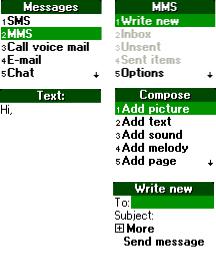
Templates
The T610/612 comes with a number of MMS predefined templates, for example templates for birthday cards, meeting requests etc.
Audio
MMS provides the ability to send and receive full sound (iMelody and AMR) messages. Not only can users share a favourite song or ring signal with a friend, they can also use the mobile phone to record sound and send it along with a message. Because sound includes speech as well as music, this extra dimension of an MMS message makes for enhanced immediacy of expression and communication. Rather than sending a downloaded birthday jingle in EMS, for example, a user can send a clip of his or her own personal rendition of “Happy Birthday”.
White Paper T610/612
displayed, as well as for how long the images and text lines are to be shown in the display
PIM communication with MMS
With MMS in the T610/612, it is easy to send and receive business cards, calendar entries and notes.
Business card (vCard)
With MMS in the T610/612, the user can send his/her business card.
Calendar entry (vCal)
With the vCal function the user can enclose a vCal entry when sending a meeting request via MMS.
Pictures and themes
By using the built-in digital camera in the T610/612 users can take a snapshot and immediately send it to a recipient. The ability to send pictures is one of the most exciting attributes of MMS, as it allows users to share meaningful moments with friends, family and colleagues.
Mobile picture transmission also offers inestimable utility in business applications, from sending on-site pictures of a construction project to capturing and storing an interesting design concept for later review. Editing a picture by adding text allows users to create their own electronic postcards, an application that is expected to substantially cut into the traditional postcard-sending market.
Themes (downloaded or pre-defined) can be exchanged via MMS.
SMIL presentations
SMIL stands for Synchronized Multimedia Integration Language and is pronounced “smile”. SMIL in the T610/ 612 allows the user to the create and transmit PowerPoint-style presentations on the mobile device. SMIL is an advanced XML-based protocol, and Sony Ericsson MMS supports a subset of this protocol. Using a simple media editor, users can incorporate audio and animated GIFs along with still images, animations and text to assemble full multimedia presentations.
The idea of SMIL is to allow the user to customize the page timing in PowerPoint-style presentations. The user can decide in which order the image and text will be
Notes
The T610/612 supports vNote. Notes can be sent via MMS.
.
Figure 2. Example of the creation of an MMS message.
8
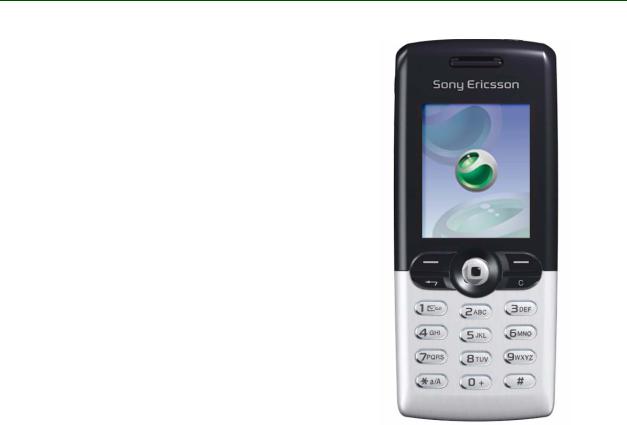
White Paper T610/612
Benefits
Essentially enabling the mobile terminal to serve as image processor and conveyor, Multimedia Messaging accommodates the exchange of important visual information as readily as it facilitates fun. Business and leisure usage of MMS will be dynamically merged, resulting in enhanced personal efficiency for users and increased network activity for operators. In short, MMS affords total usage for total communication
Because MMS uses WAP as its bearer technology and is being standardized by 3GPP, it has wide industry support and offers full interoperability, which is a major benefit to service providers and end users. Ease-of-use resulting from both the gradual steps of the messaging evolution and the continuity of user experience gained from interoperability is assured.
The MMS server, through which MMS messages are sent, supports flexible addressing (to both normal phone numbers (MSISDN) and e-mail accounts), which makes user interface more friendly and allows greater control for operators. The MMS server, moreover, is responsible for the instant delivery feature of MMS.
MMS technical features
The MMS standard, just like SMS, offers store-and- forward transmission (instant delivery) of messages, rather than a mailbox-type model. MMS is a person-to- person communications solution, meaning that the user gets the message directly into the mobile phone. He or she doesn’t have to call the server to get the message downloaded to the mobile phone. Unlike SMS, the MMS standard uses WAP as its bearer protocol. MMS will take advantage of the high speed data transport technologies EDGE and GPRS and support a variety of image, video and audio formats to facilitate a complete communication experience.
Architecture
The MMS Centre (MMS-C) is comprised of the MMS Server, the MMS Proxy-Relay and the MMS Store. The MMS Centre is the central element of the MMS network architecture, providing storage and operational support, enabling instant delivery of multimedia messages from terminal-to-terminal and terminal-to-e-mail, and supporting flexible addressing. The centre’s MMS Proxy-Relay interacts with the application being run on the MMS-ena- bled terminal to provide various messaging services. WAP is used as bearer of an MMS message between the MMS-C and the MMS client (application). The WAP Gateway is used for delivery and retrieval of messages.
9
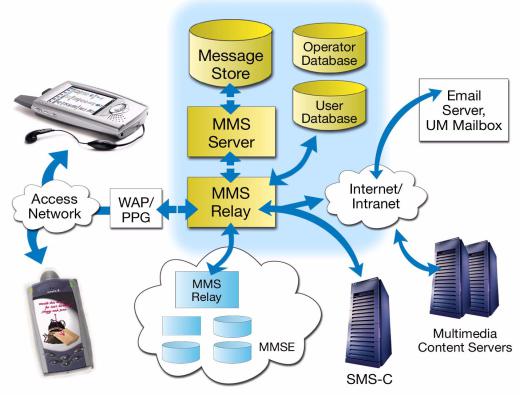
White Paper T610/612
Figure 3. The architecture of MMS
Message conversion
The MMS-C is able to perform limited message conversion - for example, from MMS to SMS - so that processing and air time is not wasted in sending messages to mobile terminals that do not have adequate capability to receive them. It also handles service aspects such as store and forward, guaranteed delivery, subscriber preferences, operator constraints, and billing information. The MMS-C also vouches for high quality messaging, e.g. by format conversion. This means that the MMS-C recognizes which formats are supported in the mobile phone, and adapts the MMS messages to these formats.
OTA configuration
Users can easily get MMS into their phone. MMS supports OTA, meaning that the user does not have to configure the settings manually. The configuration is done by the operator.
10

White Paper T610/612
EMS (Enhanced Messaging Service)
EMS uses existing SMS infrastructure and industry standards, keeping investments to a minimum for operators and providing a familiar user interface and compatibility with existing phones.
Sounds and melodies
EMS gives the user the ability to send and receive melodies. These can be pre-defined sounds, downloaded from the Internet, received in SMS messages or composed by the user on the phone keypad or a PC.
Several sounds and melodies can be inserted in one
message, and they can be combined with pictures.
Pictures and animations
Phones supporting EMS include a set of pre-defined animations. New pictures and animations can be downloaded from the Internet or received in SMS messages.
Pictures can be created and edited in the phone using a built-in Picture Editor. Several pictures can be inserted in one message, and they can be combined with sounds and melodies.
Messaging using EMS
Concatenated messages
A part of the EMS standard is the support for concatenated messages, which means that the phone is able to automatically combine several messages both when creating and receiving EMS. This is useful to be able to build and display messages with rich content since the amount of information in each SMS is limited by the SMS standards.
relevant ETSI/ 3GPP committees. The major mobile phone manufacturers and most operators are actively contributing to the 3GPP standards. Hence the EMS standard has evolved and is now stable and complete as part of the 3rd Generation Partnership Project (3GPP) technical specification.
Compatible with SMS standards
Users will find EMS as easy to use as SMS. At the moment 15 billion SMS messages, are sent every month worldwide. Roughly 80% of this traffic is user-to-user i.e. mobile phone users sending short messages to each other using the keypad of the phone to enter text. The remaining 20% is shared by downloads and notifications of different kinds.
EMS dynamics
An EMS message can be sent to a mobile phone that does not support EMS, or only supports part of EMS. All the EMS elements i.e. text formatting, pictures, animations and sounds are located in the message header. The EMS contents will be ignored by a receiving phone that does not support the standard. Only the text message will be displayed to the receiver. This is true consumerfriendly standardization.
Huge business potential
Network operators can now enhance their services and attract more customers by offering pictures, animations, ring signals and melodies for download at their portals. Operators can charge more per EMS message since it contains more data. Thereby EMS adds more value to the operators and to the end users.
Standards
The Enhanced Messaging Service (EMS) was first submitted to the standards committees by Ericsson. Ericsson presented the outline structure of EMS to the
Examples of EMS contents and applications
A wide range of contents, applications and services may be developed. Below is a list of examples and areas where messaging can be enhanced with EMS.
User-to-user message
Messages usually originating from the keypad of a mobile phone can include pictures, melodies, formatted text with EMS.
Voice and e-mail notifications
Notifying mobile phone users that they have new voice or fax mail messages waiting - including icons or
11
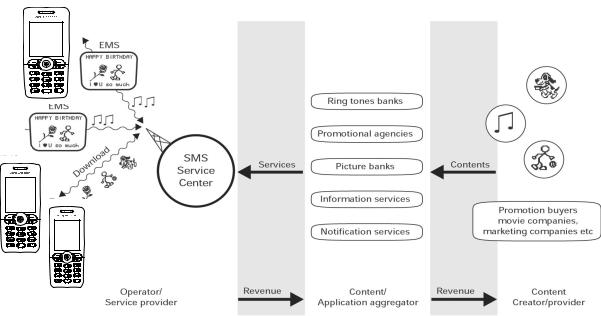
melodies with EMS.
Unified messaging
The user typically receives a short message notifying them that they have a new message in their unified messaging box, with icons or formatted text further enhancing the message.
Internet e-mail alerts
An Internet e-mail alert is provided in the form of a short message that typically details the sender of the e-mail, the subject field and first few words of the e-mail message, and in this case formatted text is excellent to identify message elements.
Ring signals
Downloading ring signals from the Internet
News & commercials
World news illustrated, sports scores and news headlines, finance and stock market news with diagrams and tickers, commercial product promotions, weather reports with maps, tunes from TV commercials as ring signals.
Info & entertainment
Ring signals, e-greetings, football club logo, joke-of-the- day illustrated by pictures or sound, horoscopes, movie related animation or theme song, TV show promotions,
White Paper T610/612
music artist promotions, lottery results, food and drinks pictures and recipes, mood-related pictures.
Corporate
Flight schedules, pre-installed corporate logos, map snippets and travel info, company branded icons and ring signals, corporate e-mail notifications, affinity programmes where companies notify customers of product updates etc., banks notifying customers about new services and interest rates, call centres providing answers to questions about a product, vehicle positioning combining EMS with Global Positioning System (GPS) position information, job dispatch with delivery addresses for sales or courier package delivery, using EMS in a retail environment for credit card authorization, remote monitoring of machines for service and maintenance purposes.
Using WAP, WAP And SMS for download
Already today services exist on the Internet where users can create melodies, and view icons and pictures, subscribe to entertainment and informations services. These may develop further in the future to support access via PC over the Internet, from the phone using WAP and even with an SMS request interface.
The diagram shows a model over the possibilities with Enhanced Messaging Service.
12
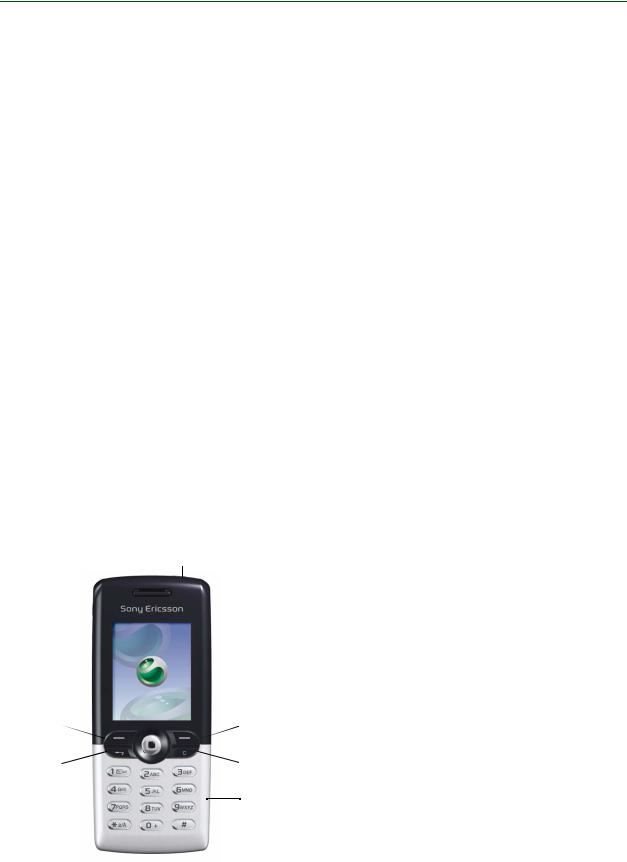
White Paper T610/612
New and innovative user interface
The T610/612 has a new, innovative user interface which enables the user to manage the phone in an easy and efficient way. Combined with attractive graphics in a wide variety of styles, the new user interface gives the user a new and stimulating experience.
The development of the new user interface is founded on usability tests performed on a wide range of mobile phones - Sony Ericsson phones as well as competitors’. The result is a new interface that is easier and quicker to use than the vast majority in products on the market.
Back and delete
The Back key enables the user to go back one step at the time. It makes it easy to find the way back, but more importantly gives the possibility to recover from mistakes. To press and hold the Back key is an instant return to stand by.
The C key is used to delete items and to turn off sounds:
•Press and hold in Stand by - activate silent mode
•Press and hold during ongoing call - mute
•Normal press during incoming call - mute ring
The keys to efficiency
The lay out of the keys are one of many new and improved elements in the T610/612, helping the user to find functions and features in the phone quickly and easily. Conveniently and ergonomically grouped together on the front, the two soft keys, a joystick, the back key and the C key enable the user to navigate, select and perform actions.
Actions and options
The left and right soft keys perform the actions shown immediately above these keys in the display. The most frequently used actions are always available on the left soft key. Other actions are accessible on the right soft key, directly on the key or via the More list. Since most of the common actions are carried out by the left soft key, the back key is conveniently placed immediately under it.
On / Off key
More Features
The key features in the phone are easily accessible, and the main menu is reached by a press with the joystick in stand by. It is also accessible during an ongoing call, which allows for multitasking - an air time generator. The main menu gives an overview of all functions and features in the phone.
Actions in the T610/612 are always carried out in the most efficient way, and there is always a visible status bar at the top of the display. The status bar extends the usage of non voice features by displaying icons and indicators of ongoing actions.
The already popular Themes in Sony Ericsson mobile phones have been further developed and improved in the T610/612, enabling the user to personalize the phone with pictures, colours, wallpapers, etc. The Themes and all their features are displayed in the large 65 k colour screen, which gives a unique user experience.
Camera key |
|
|
|
Internet key |
|
|
|||
Volume key |
|
|
|
|
|
|
|
|
Left soft key |
Right soft key |
|
Back key |
C key |
|
|
|
Number keys |
|
|
|
|
|
|
13

White Paper T610/612
Java
The T610/612 supports J2ME CLDC/MIDP. It is ready to run applications written for handheld computers and mobile phones.
Applications are easily downloaded directly to the T610/ 612 using the browser, or may be installed from a connected PC. Applications such as the currency converter can obtain the latest exchange rates from the Mobile Internet and then make up-to-date calculations. It is also possible to access and download data from a company server.
T610/612 supports JSR-135 allowing control of the synthesizer for MIDI, I-melody and Tone sequence playback.
Soft keys
When executing a MIDP application a lower portion of the screen is reserved for displaying soft keys associated with the application. The appearance of this soft key area at runtime depends on which base class the displayed application is derived from.The left soft key is for the first command in the command list and the right soft key is for the “More” list and “Help”.
Optional download features
The browser can download JAR/JAD files from WAP and HTML pages provided that the server supports the actual file types. T610/612 can also download JAD/JAR files from ordinary WAP servers provided that they support the mime type for each of the file types.
Sandbox
J2ME/CLDC uses a sandbox. The sandbox includes a number of system components working together to ensure that untrusted applications cannot gain access to system resource.
J2ME
CLDC
Sandbox
Supported protocols
The T610/612 supports “Sun OTA recommended practice for J2ME CLDC/MIDP” and ordinary MIDP 1.0 applications without extension API’s.
|
MIDP Application |
|
|
|
running on |
|
|
|
MIDP/CLDC/kVM |
|
Internet |
|
|
|
|
|
|
HTTP/ |
Services and pages |
|
|
Datagram |
|
|
|
with response in |
|
|
|
|
|
|
User Interface |
|
HTML format |
|
|
|
|
|
|
|
Other networked |
JAR file |
Persistent |
|
devices (datagram |
resource |
Storage |
|
communication) |
14

Sony Ericsson Advanced Developer Support
The Advanced Developer Support equips professional developers with everything they need to successfully develop world-class applications for Sony Ericsson products. With this support contract, developers get access to a high-quality online support with fast response and resolution times and up to 50 technical support incidents. They also get access to early technical product information and development tools as well as the complete range of interactive and static online support resources. This service requires a paid subscription.
Sony Ericsson Basic Developer Support
The Basic Developer Support is an annual support service package that provides developers with all the basics to successfully develop world-class applications for Sony Ericsson products. With this support contract, developers get access to a high-quality online support with same-day response and resolution times, five technical support incidents as well as the ability to purchase more. They also get access to complete technical product information and development tools as well as the whole range of interactive and static online support resources. This service requires a paid subscription.
Sony Ericsson Online Support
Some online resources are available to all developers for free. All that is needed is to register as an Ericsson Mobility World Community member. After registration, access is granted to selected technical product informa-
White Paper T610/612
tion and development tools as well as limited access to interactive and static online support resources.
General information
Implementation |
|
|
|
CLDC |
1.0 |
|
|
MIDP |
1.0 |
|
|
JSR |
135 |
|
|
Support |
Over the Air Recom- |
|
mended Practice |
|
|
Permissions |
Net Access |
|
|
|
|
Memory |
|
|
|
Heap size (RAM) |
256 KB |
|
|
Max no.of applications |
50 |
|
|
Size of applications |
Approximately 60 KB |
|
|
File system size |
2 MB |
|
|
Number of simultaneous |
One |
executing applications |
|
|
|
Note: For more information see “Java in Sony Ericsson mobile phones” at www.ericsson.com/mobilityworld/
Games
Downloadable games
The T610/612 games download is made possible by a true virtual machine. The Sony Ericsson portal for downloading of free games for the T610/612 is accessible with only one key press in the games menu. The openness of the downloadable games solution is dedicated to provide an enhanced gaming experience.
The downloadable games can fully take advantage of the phone´s interfaces, such as TCP/IP, SMS/MMS, 32 voices polyphonic sounds, vibrator and backlights. The virtual machine executes the downloading of games for the optimal game experience. The user can download an unlimited number of games as long as the file system allows it, i e until the phone memory is full.
The downloading concept includes certification of the games, which makes it possible to create a revenue chain and favourable business opportunities for network operators and content providers. The virtual machine uses true sandbox technology for the highest level of security.
Functions
Send/receive via TCP/IP |
Yes |
link |
|
|
|
Send/receive via SMS |
Yes |
|
|
Send/receive via infrared |
Yes |
|
|
Vibration on/off |
Yes |
|
|
Backlight on/off |
Yes |
|
|
15

White Paper T610/612
Functions
Full colour support |
Yes |
|
|
Certification control of |
Yes |
games |
|
|
|
True sandbox technology |
Yes |
|
|
True file support |
Yes |
|
|
Sprite detection collision |
Yes |
|
|
Built-in Unicode includ- |
Yes |
ing Chinese |
|
|
|
MIDI - Musical Instrument Digital Interface
The T610/612 contains an advanced MIDI composer that allows the user to compose melodies and ring signals in polyphonic sound. A MIDI signal or file does not contain any music. It contains binary data (information) of how a melody is played and when this data reaches a synthesizer, the synthesizer will translate the binary data to music, when connected to an amplifier with speakers so that the sound becomes audible.
The development from the iMelody format to the MIDI format means a revolution to the sound quality. The MIDI files are small, and perfect for mobile devices, which have limited storage capacity.
MIDI is a specification for a communications protocol principally used to control electronic musical instruments. MIDI is today a well known standard used by musicians, composers and arrangers.
Polyphonic ring signals
Protocol
The T610/612 has a hardware synthesizer chip, built into the mobile phone. The software controls the MIDI files, and makes sure they fit into the hardware chip. It is possible to modify the dynamics, and it is possible to make the sound escalate, start quietly and grow louder.
The T610/612 Sony Ericsson mobile phone completely supports the MIDI 1.0 detailed specification. Please visit http://www.midi.org/ for more information.
The quality of the sound heard from the speakers depends on many different things, for example on the synthesizer, the amplifier, or the speakers. An important factor for sound quality is the number of voices. The human ear cannot separate each voice if the number of voices increases above about 16, then the voices merge together. But the nuances in the music increase, and the music is experienced as more sophisticated if the number of voices increases. Many modern sound modules in synthesizers used by musicians have 16, 24 or 32 note polyphony. The number of voices used in the T610/612 is 32, which gives excellent sound quality.
Excellent sound quality – 32voices
The human ear can hear sounds from approximately 20 Hz up to 20 KHz. In most GSM mobile phones, the speech sound range is from 300 Hz to 3400 Hz, which is good enough for speaking, but quite poor for music. The T610/612 can handle up to 15000 Hz, equivalent to an FM stereo radio, which means excellent sound quality.
Wavetable synthesis
Sony Ericsson has chosen to implement the Wavetable synthesis, which consists of sampled real instruments, which gives a much higher quality than the FM-synthe- sis. Especially the treble is more distinguished.
16

Touch correct feature
The so called “Touch correct” feature makes dynamic compression possible. This equalizes the amplitude of
White Paper T610/612
the instruments included in the MIDI file, which greatly improves the sound quality, especially in melodies with big differences in amplitude.
Bluetooth™ wireless technology
The T610/612 features built-in Bluetooth wireless technology. Its short-range radio link operates in the globally available 2.4 GHz radio frequency band, ensuring fast and secure communications up to a range of 10 metres.
Bluetooth wireless technology is designed to be fully functional even in noisy radio frequency environments. All data transfer is protected by advanced error-correc- tion methods, ensuring a high level of data security. Bluetooth wireless technology facilitates instant connections, which are maintained even when the devices are not within line of sight. High-quality voice transmission is provided under adverse conditions, making it possible to use a headset connection to the T610/612 at all times.
Ericsson is a founding partner of the Bluetooth Special Interest Group (SIG). Bluetooth wireless technology devices that are expected to be available in the near future, include:
•Headsets for wireless voice transmission and remote call control
•PCs, laptops, PDAs, palmpads for data transfer, synchronization etc.
•PC cards for Bluetooth wireless technology in laptops and PDAs
•MP3 music player
•Other phones for exchanging business cards, ring signals, playing games etc.
•Digital still and motion video cameras
•Printers, hard disks and other storage devices
•Handheld scanners for text, barcodes and images
•Household appliances with built-in logic, as well as games and entertainment devices
•Access points in hotel lobbies and airports for connecting to computer networks and the Internet
• Car handsfree solutions
Using Bluetooth wireless technology in the T610/612
Key benefits include:
•True wireless connection
•Cable replacement for connecting to headsets, computers, networks, printers and other devices.
•The T610/612 identifies and maintains several devices in a pairing list.
•Radio link
•No line of sight required; the phone can remain in a briefcase or in a pocket, as long as no solid objects
are in between (whereas infrared requires line of sight).
•Secure and fast
•Data connection with a Bluetooth PC/laptop turns the phone into a modem for connecting to the Internet and for data transfer (faster than infrared or cable).
•Synchronization
•Fast synchronization, even without line of sight, of calendar and phone book with PC/laptop and PDA,
17

White Paper T610/612
and quick exchange of business cards, calendar events and melodies with other phones and devices.
Synchronize calendar and phone book
In everyday life, access to an updated calendar and addresses of friends and business colleagues is greatly appreciated. To be truly mobile, users must be able to carry their important information with them. Equipping mobile phones with Personal Information Manager (PIM) programs such as calendars, to-do lists and address books gives users access to their most important data anywhere and anytime. The information is kept updated by synchronizing with the information at the office or at home.
Hierarchical phone book with contacts
The T610/612 features a hierarchical phone book. For every contact, details such as name, home, work and mobile numbers, pager number, e-mail address and other information can be stored. The hierarchical phone book in the T610/612 is compatible with most groupware and agenda programs, such as Microsoft Outlook, enabling smooth local synchronization of contact information between the phone and a PC, via cable, Bluetooth wireless technology or IR. For remote synchronization of Contacts and Calendar over WAP, the T610/612 supports SyncML.
SyncML, an open standard for remote synchronization in the T610/612
SyncML – background
The SyncML Initiative Ltd. was founded by Ericsson, IBM, Lotus, Motorola, Matsushita, Nokia, Palm Inc., Psion and Starfish Software in February 2000. Supported by more than 60 software and hardware developers, the SyncML Initiative Ltd. seeks to develop and promote a globally open standard for remote synchronization, called SyncML. Unlike many other synchronization platforms, SyncML is an open industry specification that offers universal interoperability. Because it uses a common language, called XML, for specifying the messages that synchronize devices and applications, SyncML has been called the only truly future-proof platform for enabling reliable and immediate update of data. The benefit for the end user is that SyncML can be used almost anywhere and in a wide variety of devices, regardless of application or operating system.
What is SyncML?
SyncML is the common language for synchronizing all devices and applications over any network. SyncML leverages Extensible Markup Language (XML), making SyncML a truly future-proof platform. With SyncML any personal information, such as e-mail, calendars, todo lists, contact information and other relevant data, will be consistent, accessible and up to date, no matter where
the information is stored. For example, a calendar entry made to a mobile device on a business trip is equally available to a secretary in a network calendar. SyncML is the ultimate choice for remote synchronization.
In the T610/612, SyncML supports remote synchronization of the calendar and phone book, designed for the requirements of the wireless world
SyncML is designed specifically with the wireless world’s tight requirements in mind. SyncML minimizes the use of bandwidth and can deal with the special challenges of wireless synchronization, such as relatively low connection reliability and high network latency. SyncML supports synchronization over WAP, fixed networks, infrared, cable or Bluetooth wireless technology.
In the T610/612, SyncML enables synchronization over WAP – an ultimate solution for travellers.
18
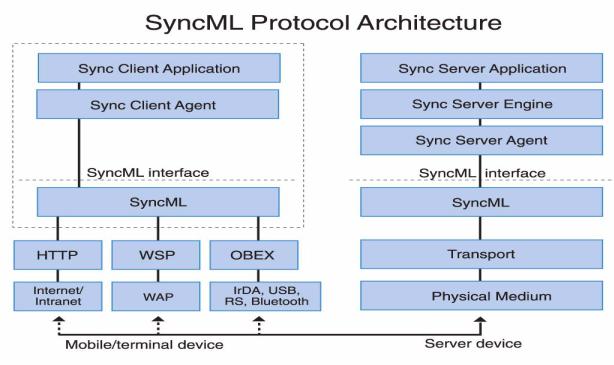
Benefits of a common synchronization protocol
End users
Today’s user of mobile devices probably uses a different synchronization product with every device. Each technology can synchronize only a few applications, or is limited to a particular type of network connection. This arrangement is expensive to install, confusing to configure and operate, and costly to administer. With SyncML, users will be able to buy devices that synchronize with a broader range of data.
Device manufacturers
Device manufacturers will benefit from a common protocol that will make the device interoperable with a broader range of applications, services, and network and transmission technologies.
Service providers
Service providers moving into the growth area of application hosting are particularly concerned that a proliferation of synchronization technologies will make it impossible to deploy and support their customers in a
White Paper T610/612
cost-effective manner. To support the range of data types and devices in use today, service providers must install and configure multiple server infrastructures, maintain and support that infrastructure, and maintain compatibility and performance. The alternative now available, to use a single solution for data connectivity, involves the risk of a tight coupling to a propriety solution. With SyncML, they will be able to provide connectivity to a wider selection of applications.
Application developers
Choosing to support multiple synchronization technologies enables an application to support more types of devices and networked data, but that choice comes at a cost. With SyncML, application developers will be able to develop an application that can connect to a more diverse set of devices and network data.
Network operators
As multiple applications that need remote synchronization over WAP are developed, there will be an automatic growth of revenue for network operators.
19

White Paper T610/612
Local synchronization
Open standard
Synchronization is possible with almost any groupware or office program, since the synchronization method complies with the open standard IrMC 1.1, as specified by the Infrared Data Association – reference http:// www.irda.org. IrMC 1.1 brings together the following standards:
•vCard 2.1 for address book information
•vCalendar 1.0 for appointment and to-do information
•ObEx (Object Exchange) for data exchange
Bluetooth wireless technology or infrared
The T610/612 synchronizes using the same protocol, regardless of connection type. It connects via Bluetooth wireless technology, infrared or cable. The cable is connected either directly to the phone or to the desktop charger.
Automatic synchronization
When infrared or Bluetooth wireless technology is switched on in the phone, the synchronization process starts automatically, as soon as the phone is within range of a compatible port on a PC or handheld device (a suitable synchronization program must be running on the device).
Microsoft Outlook provides an embedded menu for onekey synchronization.
To enhance functionality and compatibility further, the synchronization software can easily be upgraded.
The number of units that can talk to each other is unlimited. One phone can be partner with several PCs. This ensures that information from both the work PC and the home PC can be synchronized with the phone. For users that have both a desktop PC and a laptop (free version XTNDConnect PC) or a PDA (free version XTNDConnect PC), it is an efficient way to synchronize data with the phone. This way, data can also be transferred between PCs to keep them in sync.
If the synchronization software is upgraded to a full version of XTNDConnect PC, one PC can be partnered with several different phones. This is vital if, for example, each member in a work group has his/her own T610/612, and needs to synchronize with a PC. It makes it easy, for example, to download a common company phone directory to the phone book in each company mobile phone. With the full version of the synchronization software, other phone types and handheld devices, such as PDAs and Windows CE computers, can also be synchronized.
Intelligent process
A synchronization engine performs the task of synchronizing. For local synchronization, the synchronization engine is an application that runs on the desktop computer. The synchronization engine compares, updates and resolves conflicts to ensure that the information in the phone is the same as that in the computer.
Local synchronization software and the T610/612
PCs equipped with XTNDConnect PC For Ericsson will perform synchronization with Microsoft Outlook. For other groupware environments (Lotus Notes, etc.), the full version of XTNDConnect PC is required. By using Bluetooth wireless technology, infrared or the RS 232 Cable, you can easily perform a fast, local synchronization.
Integration between XTNDConnect PC For Ericsson and
XTNDConnect PC For Ericsson
This synchronization software can be downloaded from www.SonyEricssonMobile.com and provides a powerful set of functions:
•T610/612 phone book and calendar synchronization with Microsoft Outlook.
•An embedded synchronization in Microsoft Outlook, providing one-key synchronization and allowing the user to control the synchronization process with easy- to-use settings.
•PC applications supported by XTNDConnect PC For Ericsson:
•Microsoft Outlook 97, 98, 2000
•Platforms for using XTNDConnect PC For Ericsson:
•Windows 98, Me (Millennium Edition), Windows NT 4.0 and 2000.
•Pentium II recommended
•64 MB RAM recommended (minimum 32 MB)
•Other requirements:
•20 MB free hard disk space
•Bluetooth wireless technology, infrared, or cable connection
20

•Support is handled by Sony Ericsson.
XTNDConnect PC
All users of the T610/612 can easily upgrade to the full version of the synchronization software. A number of features and supported applications will then be added, including XTNDConnect Phone Viewer.
•Phone book and calendar synchronization for the T610/612.
•XTNDConnect Phone Viewer for easy data entry. All data can be created, viewed and edited on a PC.
•PC applications supported by XTNDConnect PC (full upgraded version):
•Microsoft Outlook 97, 98, 2000
•Lotus Notes 4.5, 4.6, R5
•Lotus Organizer 4.1, 5.0, 97, 97 GS, 6.0
•Symantec ACT! 3.05, 4.0, 2000
White Paper T610/612
•NetManage Ecco Pro 4.0
•GoldMine 3.0, 4.0 (StandardEdition)
•Platforms for using XTNDConnect PC:
•Windows 98, Me (Millennium Edition), Windows NT 4.0, 2000 and XP.
•Pentium II recommended
•64 MB RAM recommended (minimum 32 MB)
•Other requirements:
•20 MB free hard disk space
•Bluetooth wireless technology, infrared, or cable connection
•An embedded synchronization in Microsoft Outlook, providing one-key synchronization and allowing the user to control the synchronization process with easy- to-use settings.
•Handheld devices supported include the T610/612, palm-sized and handheld devices using Windows CE and PalmOS/ Casio Personal Organizers.
WAP services
The T610/612 has a WAP browser, supporting WAP 2.0 (WML 1.3). WAP 2.0 optimizes usage of higher bandwidths and packet-based connections of wireless networks.
Examples of pushed content would be mail alerts, messaging, news, stock quotes, contacts, meeting requests, etc.
Using the WAP browser
The WAP browser in the T610/612 is compliant with WAP 2.0 and includes WTLS class 3 as well as mechanisms for digital signatures. It supports WML and XHTML. The WAP browser in the T610/612 is also designed to access information such as timetables, share prices, exchange rates, Internet banking and other interactive services.
The built-in WAP browser in the T610/612 gives the user portable, fast and secure access to a wide variety of services, including personalized services, with new opportunities for business, individuals and service providers.
Direct Links
There are direct links in the menu system for easy download of e.g. pictures and melodies from WAP sites.
Support of XHTML
The WAP browser supports the markup languages of WAP 2.0 – XHTML Mobile Profile (XHTML-MP), XHTML Basic, a subset of XHTML-MP, IHTML, WAP Cascading Style Sheets (WCSS), WML version 1.3 and WMLScript. The subsets of the WAP standard XHTML are supported by all major WAP browsers. WAP pages authored in XHTML and WCSS can be displayed in standard PC browsers such as IE and Netscape. WAP pages authored in WML can be displayed in WAP browsers only. It is preferable, therefore, that developers use XHTML and CSS to develop content as these are pure WAP standards. WML and WMLScript are for backwards compatibility.
All of the basic XHTML and IHTML features are supported, including text, images, links, checkboxes, radio buttons, text areas, headings, horizontal rules and lists. For IHTML also blink and marquee, but not tables.
Push services
Businesses and service providers can “push” content or service indications to work groups and/or customers.
Support for cookies
T610/612 has support for cookies (client based), an application used by WAP sites to store site-specific information in the browser between visits to the site.
21
Cookies give the site owner a possibility to see when a person has visited their site. They also save the user from having to enter the same information (e.g. the password or user ID) more than once. Cookies are often used by e- commerce sites (shopping carts and wish lists).
Style sheets
T610/612 supports style sheets offering content developers more control over the way their WAP pages are displayed.
White Paper T610/612
be created once and then made accessible on a broad range of wireless networks.
Maintain customer base
Existing services can be adapted to WAP. The necessary binary encoding is handled by a WAP Gateway, allowing HTML-based services to be viewed on the WAP browser of the T610/612. An XHTML page can be viewed in both the WAP browser and in any standard Web (HTML) browser.
Sending bookmarks
WAP 2.0 enables the sending of bookmarks via infrared as well as via SMS.
Provide settings
Using SMS messages, configuration settings can be sent over the air, OTA, so that the user does not need to configure the WAP access settings manually. WAP settings may also be customized by the operator.
Adapt to phone type
The User Agent Profile function allows WAP content to be automatically optimized for the T610/612, ensuring the intended user experience.
Several bearer types
The T610/612 accesses the WAP over a standard GSM Data connection as well as over a GPRS connection (network-dependent services.)
Bandwidth efficiency
Unlike traditional Internet services, WAP services are relayed to wireless devices as binary encoded data, maximizing bandwidth efficiency. A GPRS connection further increases efficiency.
Easy create for WAP
Creating a WAP service is no harder than creating an Internet/intranet service, as WML and WMLScript are based on well-known Internet languages such as HTML and JavaScript.
Using standard tools
Service creators can use standard tools such as ASP (Active Server Page) or CGI (Common Gateway Interface) to generate content dynamically. Services can
Improve productivity
A business can use a WAP gateway to provide a secure connection to its corporate network, improving internal communication flow by making information available to mobile as well as office users.
The WAP profiles
A WAP profile holds network settings and user identification, allowing the user to switch easily between corporate services and WAP services on the Internet, simply by switching WAP profile.
The T610/612 has dynamic WAP profile handling, which means that the user can add, edit and delete WAP profiles. There are up to 5 WAP profiles.
During WAP browsing, the options button gives the user immediate access to a dynamic option menu for WAP services, similar to a mouse right-click in PC programs.
22

White Paper T610/612
Bearer type characteristics
The T610/612 accesses WAP services over IP. IP can be provided either over GSM Data or GPRS, depending on network services.
Typical differences which distinguish the bearer types are listed below.
GPRS access
The connection is maintained “constantly”, with data transmitted in packets, and transmission capacity being used by the application in use on an as-needed basis.
Higher transmission speed than with GSM Data or SMS access.
Pricing of GPRS can be dependent on the actual use of bandwidth, which means the user is charged for the vol-
ume of data transmitted, rather than the duration of the connection.
When transmitting large amounts of data, bandwidth can be increased automatically to allow faster transmission speed.
Ideal for complex pull services, browsing, data transfer, provisioning, pager services, messaging services, info services, push initiations.
GSM data access
Circuit connection of data calls, which means that the phone is connected during the entire WAP session.
Pricing is comparable to that of data calls in the network.
Gateway characteristics
A WAP Gateway provides Internet/intranet as well as WAP services to the mobile browser. A Gateway is identified by an IP number, depending on access type.
End-to-end gateway navigation
The WAP 2.0 supports E2E (End-to-End) Gateway navigation, making it possible for example for a bank to redirect its clients from the Internet gateway to its own gateway.
Security using the WAP
For certain WAP services, such as banking services, a |
• WTLS class 3 – encryption with both server and cli- |
secure connection between the phone and WAP gateway |
ent authentication. |
is necessary. An icon in the display of the T610/612 |
|
indicates when a secure connection is in use. |
|
The T610/612 is based on the WAP 2.0 (WML 1.3) |
|
specification suite, in which security functionality is |
|
specified by a technology called Wireless Transport |
|
Layer Security (WTLS). The WAP protocols for |
|
handling connection, transport and security are |
|
structured in layers, with security handled by the WTLS |
|
layer, operating above the transport protocol layer. |
|
WTLS classes define the levels of security for a WTLS |
|
connection: |
|
• WTLS class 1 – encryption with no authentication. |
|
• WTLS class 2 – encryption with server authentica- |
|
tion. |
|
23
